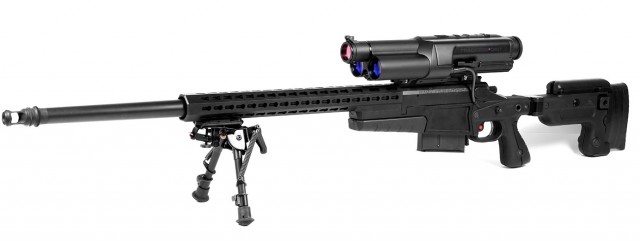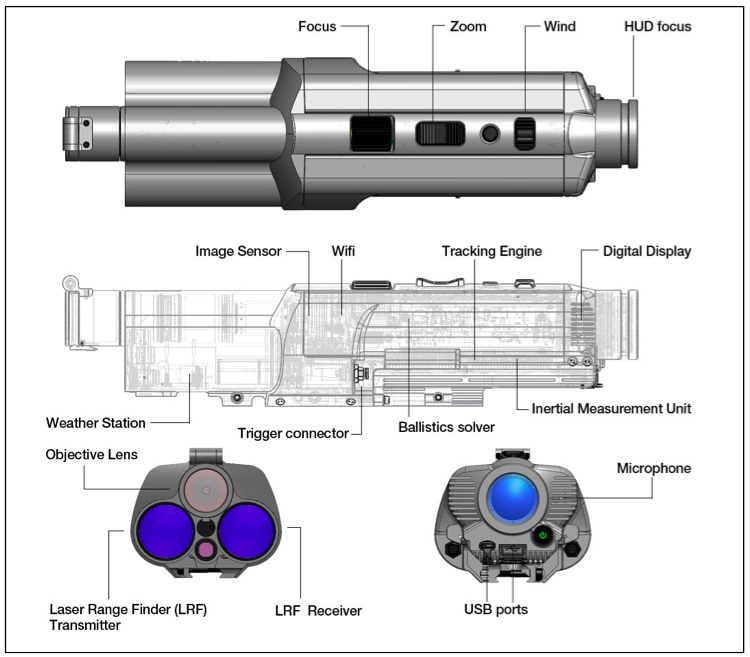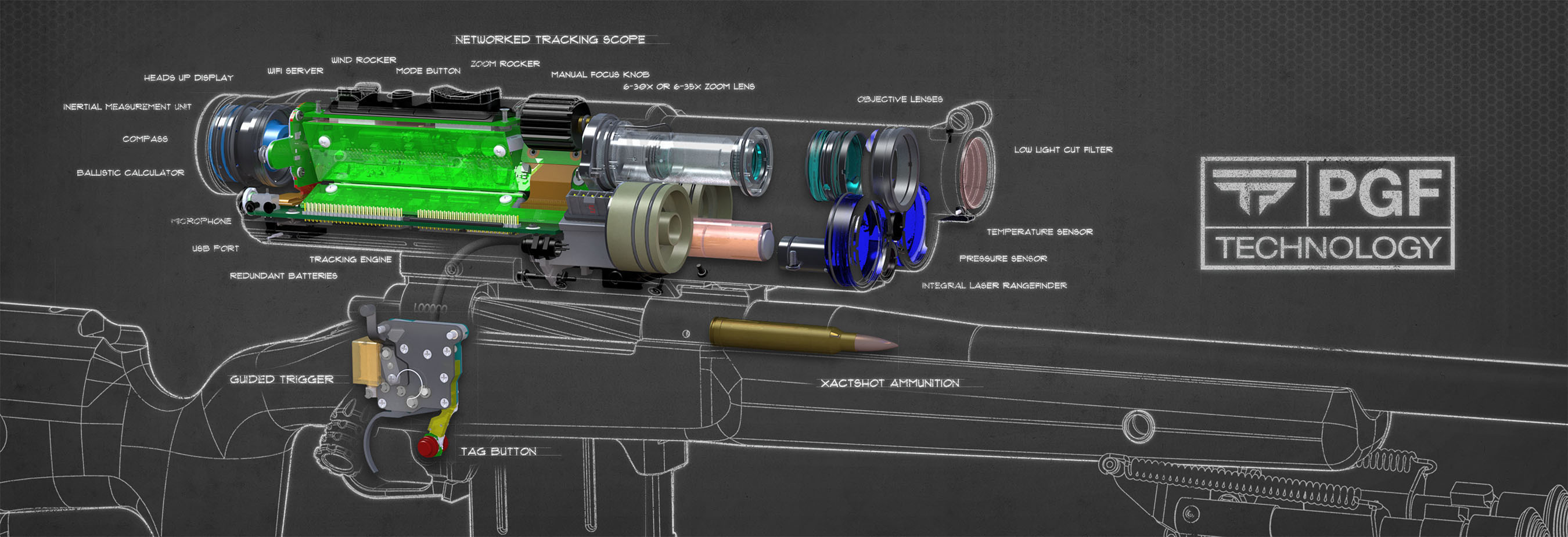proka89
FULL MEMBER

- Joined
- Jan 13, 2013
- Messages
- 1,409
- Reaction score
- 17
- Country
- Location
I thought that this might be interesting, so here it is
TrackingPoint makes "Precision Guided Firearms, or "PGFs," which are a series of three heavily customized hunting rifles, ranging from a .300 Winchester Magnum with a 22-inch barrel up to a .338 Lapua Magnum with 27-inch barrel, all fitted with advanced computerized scopes that look like something directly out of The Terminator. Indeed, the comparison to that movie is somewhat apt, because looking through the scope of a Precision Guided Firearm presents you with a collection of data points and numbers, all designed to get a bullet directly from point A to point B.

The view through the TrackingPoint's computerized optics.
The PGF isn't just a fancy scope on top of a rifle. All together, the PGF is made up of a firearm, a modified trigger mechanism with variable weighting, the computerized digital tracking scope, and hand-loaded match grade rounds (which you need to purchase from TrackingPoint). This is a little like selling both the razor and the razor blades, but the rounds must be manufactured to tight tolerances since precise guidance of a round to a target by the rifle's computer requires that the round perform within known boundaries.

The TrackingPoint XS1, chambered in a .338 Lapua Magnum, with a 27-inch Krieger barrel and 300 grain match rounds.
The image displayed on the scope isn't a direct visual, but rather a video image taken through the scope's objective lens. The Linux-powered scope produces a display that looks something like the heads-up display you'd see sitting in the cockpit of a fighter jet, showing the weapon's compass orientation, cant, and incline. To shoot at something, you first "mark" it using a button near the trigger. Marking a target illuminates it with the tracking scope's built-in laser, and the target gains a pip in the scope's display. When a target is marked, the tracking scope takes into account the range of the target, the ambient temperature and humidity, the age of the barrel, and a whole boatload of other parameters. It quickly reorients the display so the crosshairs in the center accurately show where the round will go.
Image recognition routines keep the pip stuck to the marked target in the scope's field of view, and at that point, you squeeze the trigger. This doesn't fire the weapon; rather, the reticle goes from blue to red, and while keeping the trigger held down, you position the reticle over the marked target's pip. As soon as they coincide, the rifle fires.

Mark a target, squeeze the trigger, and line up the crosshairs to the target's pip.
TrackingPoint is quick to emphasize the rifle doesn't fire "by itself," but rather the trigger's pull force is dynamically raised to be very high until the reticle and pip coincide, at which point the pull force is reset to its default. In this way, the shooter is still in control of the rifle's firing, and at any point prior to firing you can release the trigger. In the mockups the company had on display for the press to experiment with, the action appeared to be the sameI pulled the trigger and lined up the dots and the blue plastic toy gun went click.
Having the round fire when the shot is lined up rather than in immediate response to a trigger pull eliminates a tremendous amount of uncertainty from the shot. Even the most experienced shooters can upset a weapon's aim when pulling the trigger, and overcoming the reflex to twitch or preemptively move against a weapon's recoil is very, very difficult. By allowing the computer to choose the precise moment to take the shot, accuracy is greatly enhanced.

The computerized scope.
Putting lead accurately on targets is only part of what TrackingPoint's PGF system does. The computerized tracking scope contains some amount of nonvolatile storage, and like an airplane's "black box," it's constantly recording the visual feed from the optics. It also contains a small Wi-Fi server, and TrackingPoint offers an iOS app that connects to the scope via an ad-hoc Wi-Fi network and streams the scope's display to the app, allowing someone with an iPad or iPhone to act as a spotter. TrackingPoint notes that for novice hunters, having the ability to duplicate the scope's picture onto an external display makes it a lot easier for an experienced spotter to give advice on how and when to shoot.

The iPad app mirrors the scope's display, allowing a spotter to assist with shots.
There's a social media aspect, toothe scope's video recordings can be uploaded to video sharing sites like YouTube. Rather than bragging to buddies about that amazing 1000-yard shot you took at the range or out in the field last week, you can simply show them, complete with all the heads-up display data about conditions and range.
TrackingPoint had one actual rifle on display in the press room, along with several mock-ups equipped with iPhones in place of scopes. The iPhones were running a simulated version of the TrackingPoint scope software, letting demo users line up their shots on polygonal deer and hogs in a landscape much like popular hunting video games. It felt a bit like playing with an "easy mode" cheat turned on, though, as it was nearly impossible to miss, even at tremendous distances. TrackingPoint is considering selling the demo software as a standalone hunting app, though from my brief experience with it, there wasn't a whole lot of challenge to felling game once you had the mark-and-fire procedure worked out.
This might not make a compelling video game, but it certainly does make for an accurate weapon system. TrackingPoint says the "first shot success probability"that is, a shooter's ability to successfully land a round on target in a single tryis drastically increased. The TrackingPoint representatives present brought this up when I commented on the necessity of buying (more expensive) ammunition directly from TrackingPoint rather than buying or loading one's own rounds. TrackingPoint contends the ability to be drastically more precise with aiming means fewer rounds have to be fired for the same effect, ultimately saving money.

I asked about potential military applications, since they are obvious, but TrackingPoint was quick to downplay involvement with the Department of Defense. The "connected shooter" goal of the PGF system in many ways lines up with the Army's limping, on-again-off-again Land Warrior program. However, the very nature of the government contract and procurement process ensures that any technology developed for military use must go through an incredibly lengthy and convoluted development process, meeting shifting and sometimes outdated design goals along the way. TrackingPoint said that its goal is to produce the technology first, and then find the market and applications once it actually had something ready to goand this is what it has done.
The company is also keenly aware of the potential negative public perception right now around firearms and firearm manufactures, in the wake of recent mass-shooting events like the ones in Sandy Hook and Aurora. The three models of PGF are bolt-action hunting rifles, unwieldy for any kind of close-quarters work; the tracking system itself requires patience and care to line up and fire, and it doesn't appear at all to be the kind of thing a mass-shooter would employ. At this time, TrackingPoint indicated that it has no intention of producing a PGF system for anything other than bolt-action rifles.
Hunting is a controversial pastime, but it's an undeniably popular one, and TrackingPoint is dialed in very well at its target market. The price is relatively highthe rifles start at about $17,000 (a price which includes an iPad with the TrackingPoint app pre-configured and ready to go), but that isn't a huge premium over parting together one's own rifle and precision optics.
Taken from here: $17,000 Linux-powered rifle brings auto-aim to the real world
And this is the site of manufacturer:
Official Site
And a few video clips:
TrackingPoint makes "Precision Guided Firearms, or "PGFs," which are a series of three heavily customized hunting rifles, ranging from a .300 Winchester Magnum with a 22-inch barrel up to a .338 Lapua Magnum with 27-inch barrel, all fitted with advanced computerized scopes that look like something directly out of The Terminator. Indeed, the comparison to that movie is somewhat apt, because looking through the scope of a Precision Guided Firearm presents you with a collection of data points and numbers, all designed to get a bullet directly from point A to point B.

The view through the TrackingPoint's computerized optics.
The PGF isn't just a fancy scope on top of a rifle. All together, the PGF is made up of a firearm, a modified trigger mechanism with variable weighting, the computerized digital tracking scope, and hand-loaded match grade rounds (which you need to purchase from TrackingPoint). This is a little like selling both the razor and the razor blades, but the rounds must be manufactured to tight tolerances since precise guidance of a round to a target by the rifle's computer requires that the round perform within known boundaries.

The TrackingPoint XS1, chambered in a .338 Lapua Magnum, with a 27-inch Krieger barrel and 300 grain match rounds.
The image displayed on the scope isn't a direct visual, but rather a video image taken through the scope's objective lens. The Linux-powered scope produces a display that looks something like the heads-up display you'd see sitting in the cockpit of a fighter jet, showing the weapon's compass orientation, cant, and incline. To shoot at something, you first "mark" it using a button near the trigger. Marking a target illuminates it with the tracking scope's built-in laser, and the target gains a pip in the scope's display. When a target is marked, the tracking scope takes into account the range of the target, the ambient temperature and humidity, the age of the barrel, and a whole boatload of other parameters. It quickly reorients the display so the crosshairs in the center accurately show where the round will go.
Image recognition routines keep the pip stuck to the marked target in the scope's field of view, and at that point, you squeeze the trigger. This doesn't fire the weapon; rather, the reticle goes from blue to red, and while keeping the trigger held down, you position the reticle over the marked target's pip. As soon as they coincide, the rifle fires.

Mark a target, squeeze the trigger, and line up the crosshairs to the target's pip.
TrackingPoint is quick to emphasize the rifle doesn't fire "by itself," but rather the trigger's pull force is dynamically raised to be very high until the reticle and pip coincide, at which point the pull force is reset to its default. In this way, the shooter is still in control of the rifle's firing, and at any point prior to firing you can release the trigger. In the mockups the company had on display for the press to experiment with, the action appeared to be the sameI pulled the trigger and lined up the dots and the blue plastic toy gun went click.
Having the round fire when the shot is lined up rather than in immediate response to a trigger pull eliminates a tremendous amount of uncertainty from the shot. Even the most experienced shooters can upset a weapon's aim when pulling the trigger, and overcoming the reflex to twitch or preemptively move against a weapon's recoil is very, very difficult. By allowing the computer to choose the precise moment to take the shot, accuracy is greatly enhanced.

The computerized scope.
Putting lead accurately on targets is only part of what TrackingPoint's PGF system does. The computerized tracking scope contains some amount of nonvolatile storage, and like an airplane's "black box," it's constantly recording the visual feed from the optics. It also contains a small Wi-Fi server, and TrackingPoint offers an iOS app that connects to the scope via an ad-hoc Wi-Fi network and streams the scope's display to the app, allowing someone with an iPad or iPhone to act as a spotter. TrackingPoint notes that for novice hunters, having the ability to duplicate the scope's picture onto an external display makes it a lot easier for an experienced spotter to give advice on how and when to shoot.

The iPad app mirrors the scope's display, allowing a spotter to assist with shots.
There's a social media aspect, toothe scope's video recordings can be uploaded to video sharing sites like YouTube. Rather than bragging to buddies about that amazing 1000-yard shot you took at the range or out in the field last week, you can simply show them, complete with all the heads-up display data about conditions and range.
TrackingPoint had one actual rifle on display in the press room, along with several mock-ups equipped with iPhones in place of scopes. The iPhones were running a simulated version of the TrackingPoint scope software, letting demo users line up their shots on polygonal deer and hogs in a landscape much like popular hunting video games. It felt a bit like playing with an "easy mode" cheat turned on, though, as it was nearly impossible to miss, even at tremendous distances. TrackingPoint is considering selling the demo software as a standalone hunting app, though from my brief experience with it, there wasn't a whole lot of challenge to felling game once you had the mark-and-fire procedure worked out.
This might not make a compelling video game, but it certainly does make for an accurate weapon system. TrackingPoint says the "first shot success probability"that is, a shooter's ability to successfully land a round on target in a single tryis drastically increased. The TrackingPoint representatives present brought this up when I commented on the necessity of buying (more expensive) ammunition directly from TrackingPoint rather than buying or loading one's own rounds. TrackingPoint contends the ability to be drastically more precise with aiming means fewer rounds have to be fired for the same effect, ultimately saving money.

I asked about potential military applications, since they are obvious, but TrackingPoint was quick to downplay involvement with the Department of Defense. The "connected shooter" goal of the PGF system in many ways lines up with the Army's limping, on-again-off-again Land Warrior program. However, the very nature of the government contract and procurement process ensures that any technology developed for military use must go through an incredibly lengthy and convoluted development process, meeting shifting and sometimes outdated design goals along the way. TrackingPoint said that its goal is to produce the technology first, and then find the market and applications once it actually had something ready to goand this is what it has done.
The company is also keenly aware of the potential negative public perception right now around firearms and firearm manufactures, in the wake of recent mass-shooting events like the ones in Sandy Hook and Aurora. The three models of PGF are bolt-action hunting rifles, unwieldy for any kind of close-quarters work; the tracking system itself requires patience and care to line up and fire, and it doesn't appear at all to be the kind of thing a mass-shooter would employ. At this time, TrackingPoint indicated that it has no intention of producing a PGF system for anything other than bolt-action rifles.
Hunting is a controversial pastime, but it's an undeniably popular one, and TrackingPoint is dialed in very well at its target market. The price is relatively highthe rifles start at about $17,000 (a price which includes an iPad with the TrackingPoint app pre-configured and ready to go), but that isn't a huge premium over parting together one's own rifle and precision optics.
Taken from here: $17,000 Linux-powered rifle brings auto-aim to the real world
And this is the site of manufacturer:
Official Site
And a few video clips:
Last edited by a moderator:




















